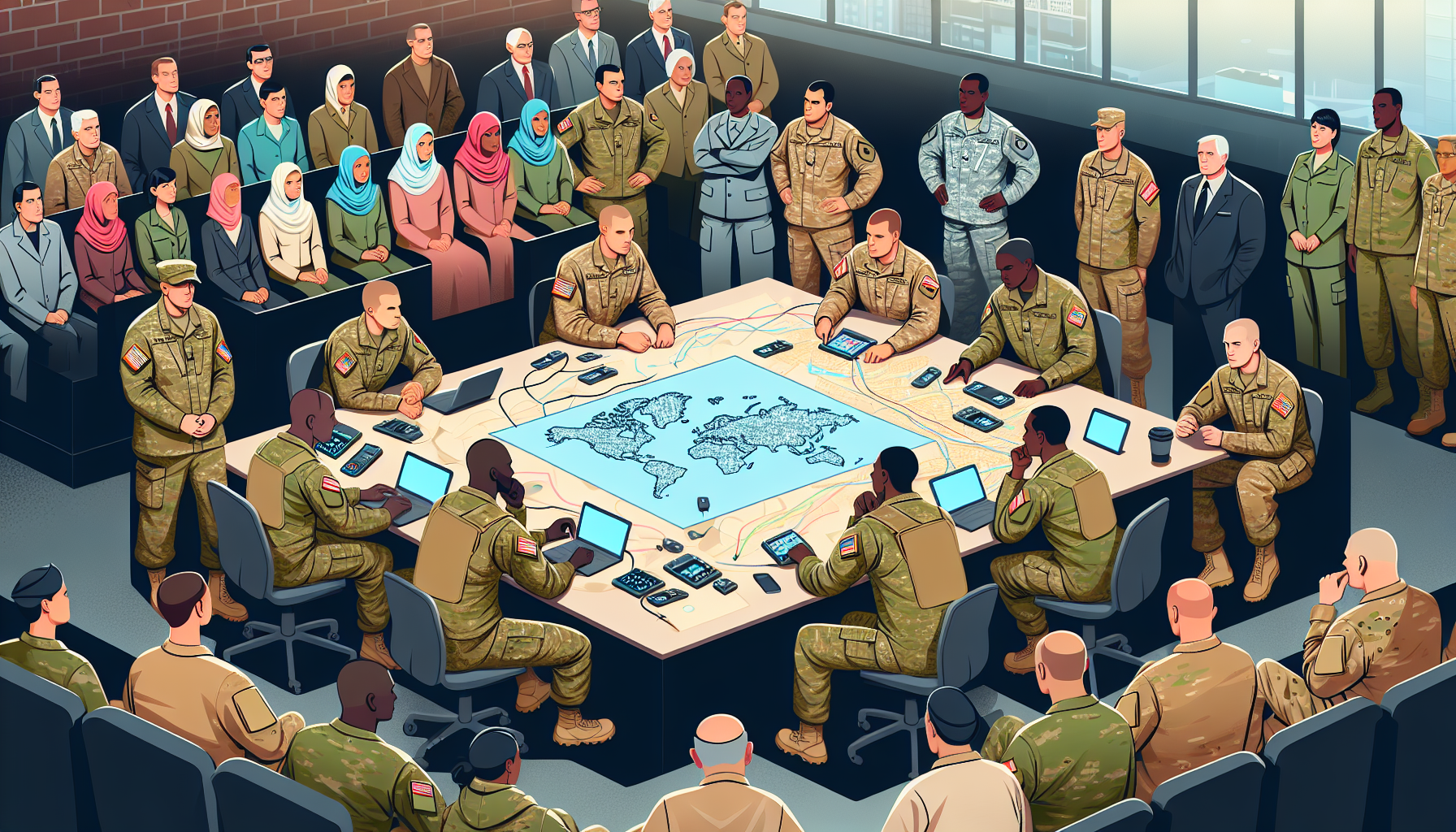Definition
The Army Service Component Command (ASCC) is a term used in military operations to describe a command organization within the United States Army. These organizations are responsible for fulfilling operational and administrative missions in their respective geographical areas or theaters of operation. In essence, an ASCC serves as the primary link between a Combatant Command and the Army’s forces assigned to that command, ensuring effective coordination and support.
Key Takeaways
- Army Service Component Command (ASCC) is a major subordinate command within the U.S. Army, which serves as the primary interface between the Army and the respective Combatant Commanders (CCDRs) for the purpose of planning, preparing, and executing operations within their assigned areas of responsibility.
- ASCCs provide operational and administrative control for Army forces assigned to each Combatant Command, ensuring that these forces are ready, trained, and equipped for a variety of missions, including providing support in humanitarian efforts, natural disasters, and combat operations.
- There are multiple ASCCs in the U.S. Army framework, each responsible for different geographical regions and tailored to meet the unique needs and challenges of their respective combatant commands. Examples of ASCCs include United States Army Europe (USAREUR), United States Army Central (USARCENT), and United States Army Pacific (USARPAC).
Importance
The term Army Service Component Command (ASCC) is important because it refers to a high-level organizational structure within the United States Army, responsible for overseeing and integrating the diverse aspects of Army capabilities within a geographic or functional combatant command.
These commands play a crucial role in maintaining the readiness and effectiveness of Army forces, aligning and tailoring support to the specific requirements of the assigned combatant command.
Through effective coordination, the ASCC ensures seamless synchronization between active Army, Army Reserve, and National Guard units while supporting joint and combined operations.
This command structure enhances the Army’s responsiveness, decision-making, and mission accomplishment in support of the United States’ global national security objectives.
Explanation
The Army Service Component Command (ASCC) serves a pivotal role in coordinating and synchronizing the efforts of multiple units and agencies within the US Army towards the accomplishment of strategic objectives. An effective tool in streamlining communication, the ASCC’s primary purpose lies in bridging the gap between higher headquarters, such as combatant commands, and subordinate units.
In doing so, the ASCC facilitates seamless cooperation among various entities, ultimately propelling the US Army towards mission success. Furthermore, as the senior army echelon in a theater of operation, the ASCC possesses the authority to allocate critical resources and manage logistics, playing an indispensable part in orchestrating a rapid, coordinated response in times of crisis.
ASCCs demonstrate a considerable degree of versatility, as these commands adapt and cater to the unique requirements of their assigned combatant commands. By integrating with best practices, knowledge, and expertise from different echelons, ASCCs cultivate a thorough understanding of a combatant command’s priorities and vision, ultimately driving the operational and tactical planning in alignment with said objectives.
Equipped with this contextual understanding, ASCCs also maintain responsibility for providing and managing administrative, as well as combat and operational support, further amplifying their utility during diverse military operations. In summary, the Army Service Component Command’s purpose and significance lie in its ability to synchronize and integrate efforts across the US Army, a vital element in realizing objectives within the complex, dynamic landscape of modern military operations.
Examples of Army Service component command (ASCC)
United States Army Forces Command (FORSCOM): FORSCOM is the largest Army Service Component Command in the United States, with headquarters at Fort Bragg, North Carolina. Its primary mission is to provide trained and ready forces to Combatant Commanders worldwide. FORSCOM trains, mobilizes, deploys, sustains, transforms, and reconstitutes conventional forces, providing relevant and ready land power to the joint force.
United States Army Pacific (USARPAC): As the ASCC under the United States Indo-Pacific Command, USARPAC has its headquarters in Fort Shafter, Hawaii. Its mission is to provide ready land forces capable of conducting a full spectrum of operations throughout the Indo-Asia Pacific region. USARPAC works with regional partners to build relationships, maintain security and stability, and respond to crises or contingencies.
United States Army Europe and Africa (USAREUR-AF): Headquartered in Wiesbaden, Germany, USAREUR-AF serves as the ASCC under both United States European Command and United States Africa Command. Its main mission is to assure allies and partners, deter adversaries, enable the U.S. Army, and protect the nation through developing strong relationships, preparing and deploying trained forces, and ensuring strategic access to critical infrastructure and lines of communication.
FAQ: Army Service Component Command (ASCC)
What is an Army Service Component Command (ASCC)?
An Army Service Component Command (ASCC) is a command within the United States Army that acts as the primary source of theater-specific support for geographical unified combatant commands. Each of these commands is responsible for planning, providing, and managing resources for their assigned regions in coordination with other military services and defense agencies.
What are the roles and responsibilities of an ASCC?
An ASCC has several key roles and responsibilities, including but not limited to: providing trained and ready forces for combatant commanders, planning and executing operational support missions, supporting theater security cooperation, overseeing administrative and logistical operations within their assigned regions, and coordinating with joint, interagency, and multinational partners.
How is the command structured?
Each ASCC is led by a commanding general (typically a 3-star general), who is responsible for planning and executing operational support missions in their assigned area. The ASCC contains various subordinate commands and units, tailored to specific operational requirements. The structure of an ASCC may differ depending on its assigned missions and region, but generally, it includes a headquarters element, combat support and sustainment units, and direct reporting units from various Army disciplines.
Which combatant commands are supported by ASCCs?
ASCCs are responsible for supporting the following geographical unified combatant commands: U.S. Central Command (USCENTCOM), U.S. European Command (USEUCOM), U.S. Indo-Pacific Command (USINDOPACOM), and U.S. Southern Command (USSOUTHCOM). Additional ASCCs support U.S. Africa Command (USAFRICOM) and U.S. Northern Command (USNORTHCOM).
What is the difference between an ASCC and other major Army commands?
An Army Service Component Command (ASCC) focuses primarily on supporting a specific combatant command within a designated geographic area, whereas other major Army commands may have broader responsibilities across multiple regions or worldwide. For example, Training and Doctrine Command (TRADOC) is responsible for developing doctrine, training, and education for the entire Army, whereas an ASCC is primarily responsible for providing theater-specific support to combatant commanders.
Related Military Operation Terms
- Active Duty
- Reserve Component
- National Guard
- Operation and Maintenance Budget
- Force Readiness
Sources for More Information
 Benefits.com Advisors
Benefits.com Advisors
With expertise spanning local, state, and federal benefit programs, our team is dedicated to guiding individuals towards the perfect program tailored to their unique circumstances.
Rise to the top with Peak Benefits!
Join our Peak Benefits Newsletter for the latest news, resources, and offers on all things government benefits.




















